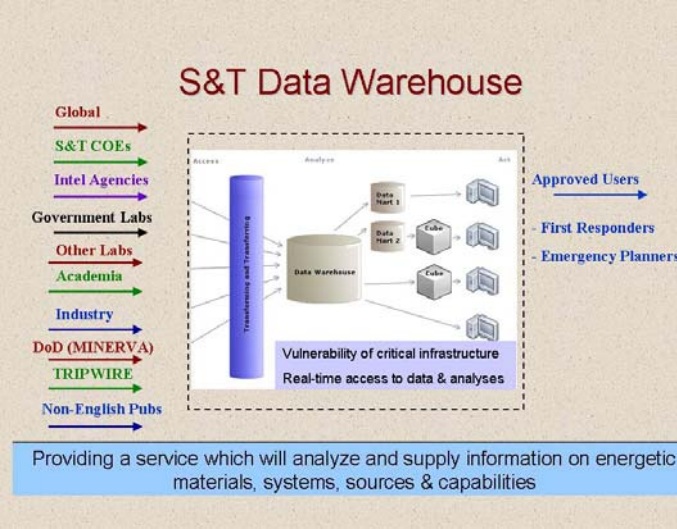![]() Energetic Data Warehouse
Energetic Data Warehouse
PI: Dylan Hazelwood and Dr. Davinder K Anand
Design
There is a pressing national need to assemble a
repository of information and databases affiliated
with energetic materials and related information,
including a list of regionally located cadre of
energetics experts for providing real-time insight
in the case of an energetics event.
The data warehouses conceptually are a computerbased information systems that are home for“secondhand” data that originated from either
another application or from an external system or
source. Warehouses optimize database query and
reporting tools because of their ability to analyze
data, often from disparate databases and in
interesting ways. They are a way for users to
extract information quickly and easily in order to
answer critical questions. These systems are readonly, integrated databases designed to answer
comparative and “what if” questions. Unlike
operational databases that are set up to handle
transactions and that are kept up to date as of the
last transaction, data warehouses are analytical,
subject-oriented, and are structured to aggregate
transactions as a snapshot in time.
The Warehouse
The data warehouse shown for our application will
serve as a resource (energetic-related knowledge
management (KM) system).
The warehouse will:
• focus on providing a valuable user
experience by improving information access,
enhancing the quality of decisions, and
promoting cross-functional integration.
• integrate commercial off-the-shelf components.
• collect energetic-related information from
validated sources on a regular basis and
integrate it with geographic information
system (GIS) data sets.
• establish data-models and integrate the
validated information into a time-stamped
energetic-related picture.
• ensure that the data is properly safe-guarded,
validated, and maintained.
The system will focus on scalability (growth), security (user and system safeguards), timely delivery of information (bandwidth), and ease of use (must be seen as a value-added). The repository of information will have COTS frontend, ad hoc query capability to enable analyses by a subject matter expert (SME), web-portal promoting first responder and emergency planner teaming, collaboration, streaming-news analyses, and sharing of lessons learned. It is our goal to satisfy overall user requirements by utilizing existing data sets as much as possible. The data in a data warehouse should be reasonably current, but not necessarily up to the minute, although developments in the data warehouse industry have made frequent and incremental data dumps more feasible.


